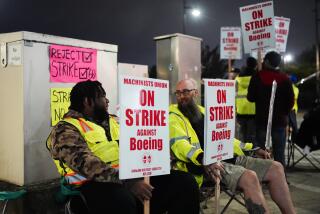GM, UAW Constituencies Hold Key to Strike Results
DETROIT â As the General Motors strikes widened Friday, the question of how long they will last depended largely on the backbone of several players who have serious interests in the outcome.
GM, the nationâs No. 1 industrial company, is banking on the support of Wall Street investors and car dealers. Both have long encouraged the auto maker to take tough steps to become more efficient.
The United Auto Workers union is relying on the support of its nonstriking members and a restive public that in the last year has shown more sympathy to challenges to union jobs and living standards.
In the simplest terms, the struggle unfolding in Flint, Mich., is a high-stakes game of chicken. While the outcome is likely to be presented as a compromise, the ultimate winner will be the one that can withstand the rising pressures and financial pain the longest.
âThis really is a Gettysburg,â said Sean McAlinden, labor economist at the University of Michigan.
GM, which has a $13-billion cash reserve on hand, clearly anticipated--and many say provoked--the strikes, now in their fourth week. With rivals getting ever leaner, GM sees this as a life-and-death showdown over its need to become more efficient and to staunch its market share slide.
The UAW says the struggle is about jobs. The union, which has lost half its members since 1979 and more recently a prolonged series of strikes with Caterpillar Inc., argues that GM is using the mantra of global competitiveness as a cover to eliminate high-paying U.S. jobs.
Both GM and the UAW are engaged in extensive public relations efforts to garner support. So far the confrontation has not resonated nationally with the same force as last yearâs United Parcel Service-Teamsters dispute. This is largely because the immediate effects are concentrated in the Midwest and the ramifications for consumers have thus far been muted.
The strikes, which began June 5 and 11 at two Flint parts plants, have brought GM operations to a near-standstill. The auto maker has idled 26 of 29 assembly plants, closed 100 parts plants and by Friday had laid off 162,600 workers, or more than half its 319,000 hourly workers throughout North America, the company said.
GM plants are scheduled to be closed for the next two weeks because of a normal summer vacation shutdown. That means the earliest the company could restart operations is mid-July. Expectations are that the strikes could last longer, perhaps into August or September. Negotiations are continuing daily, but no progress has been reported.
âThey are settling in for trench warfare,â said Joseph Phillippi, analyst with Lehman Bros. in New York.
GM says that the two parts plants are losing money and that the union has resisted efforts to increase efficiency. The UAW says GM has reneged on investment promises that could increase plant productivity.
The walkouts already have cost GM $1 billion in second-quarter profit, analysts said. Each week the plants are closed adds another $500 million in losses.
Wall Street has generally supported GMâs efforts to improve its operations by trimming workers and unprofitable business lines. Investors say short-term strike losses are acceptable if GM gets meaningful concessions that will yield long-term gains.
Two years ago, GM lost about $900 million during a strike over outsourcing work to nonunion suppliers at two Dayton, Ohio, parts plants. GM won the right to outsource while the union got commitments for new jobs. The companyâs stock price rose during the strike.
This time around, Wall Street appears less enthusiastic. GMâs stock price has declined 11.3% since the start of the first strike, as analysts have reduced their earnings estimates for the second quarter. GM shares declined $1 to close at $66.88 Friday on the New York Stock Exchange.
Although GM has demonstrated that it has the financial clout to take a $1-billion blow to its bottom line, analysts question whether investors will stick with the auto maker if strike losses climb to $3 billion or more.
âIf GM settles without achieving significant improvements in efficiency, there will be grave disappointment,â said John Casesa, analyst with Wertheim Schroder in New York.
Investors and dealers also are concerned that lengthy strikes could lead to permanent market share losses. GM commanded about 50% of the U.S. market in 1970 but has only 31% today. Earlier this year, the auto maker launched a costly price war with hefty rebates in an effort to keep its market share above the psychologically important 30% level.
While GM dealers still have several weeksâ supply of most vehicles, many are reporting shortages of popular trucks, such as the Chevrolet Tahoe sport-utility and Chevy/GMC full-size pickups.
The pickups are among GMâs most popular and profitable vehicles. The strikes come just as GM is set to introduce the redesigned Chevy Silverado and GMC Sierra. Dealers are worried that any launch delay will cost them customers and profits.
If the showroom and Wall Street are GMâs pressure points, then the laid-off rank and file are the UAWâs. By putting financial heat on union workers, GM hopes to create divisions within the UAW and force a quicker settlement.
The most immediate problem for the workers is loss of income. The 9,200 pickets are supported by $150 a week from the UAWâs $880-million strike fund.
Jim Tackabury, 47, a self-described GM brat and striking forklift operator, said he began setting aside money months ago in anticipation of a strike. With two children still in school, he and his wife are cutting back spending.
âItâs going to be tough making ends meet for a while,â he said.
Furloughed workers, many of whom normally make as much as $1,000 a week with overtime, are eligible for state unemployment benefits of roughly $200 to $300 a week. GM, however, is challenging the unemployment payments. The auto maker also is considering cutting off health benefits to laid-off workers.
In addition to these financial levers, GM has issued hard-line messages to employees suggesting that the strikes could lead to the closing of inefficient plants and the elimination of some product lines.
Harley Shaiken, a labor economist with UC Berkeley, said the companyâs pressure tactics will raise unease among laid-off workers but are unlikely to shake their backing of the unionâs leadership.
âThese workers know that it could be their jobs on the line next,â he said.
Unlike last yearâs UPS strike, the GM walkouts have not prompted a strong public reaction nationwide. But a poll of Michigan residents by the Detroit Free Press found that 44% favored the union and 24% the company, with the rest undecided or having no opinion. The pollsters attributed the results to the unionâs message that the strikes are about moving jobs out of the state.
The current strikes also evoke memories of a bitter battle between the UAW and Caterpillar earlier this decade. Like GM, the farm equipment maker also cited global competition as it demanded work-rule changes from the union. The UAW responded with a series of strikes but eventually capitulated when the company hired replacement workers and thousands of union members crossed the picket lines.
Labor experts do not foresee such tactics in the current strikes. Rather, they expect that GM and the UAW will eventually reach a compromise that allows both sides to claim victory. But with only broad outlines of any agreement likely to be disclosed, it could take months to decipher who got the upper hand.






